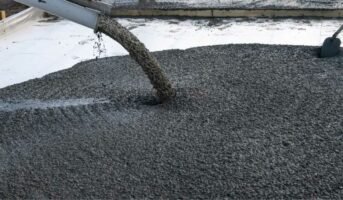The M25 concrete ratio, which denotes the proportion of cement, sand, and aggregate, is 1:1:2. It essentially means that if 1 kg of cement is used to make concrete, 1 kg of sand and 2 kg of aggregate should also be used.
- “25” stands for compressive strength @ 28 Days in N/mm2, and “M” stands for mix ratio of cement, sand, and aggregate.
- The Indian Standard IS 456:2000 can be used to skillfully prepare M25 Concrete, which is nominal concrete.
- Normally, concrete needs to be fully hydrated, with 38% of its weight in water.
- According to Indian Standard IS 456:2000, the w/c ratio ranges from 0.4 to 0.6 for nominal mix (i.e., M10, M15…, and M25).
- Commonly, a w/c ratio of 0.4 to 0.45 is used for M25 concrete.

Source: Pinterest
M25 concrete ratio: Quick facts
| Code | Indian Standard IS 456:2000 |
| Ratio | 1:1:2 |
| Compressive Strength | 25 MPa |
| Uses |
(Usually applied to large structures or tasks) |
| Grade Category | Standard Grade ( Nominal Mix ) |
| Required Water Cement Ratio |
|
M25 concrete ratio: How does concrete mix design work?
Sand (fine aggregate), cement, and coarse aggregate are the main components of concrete. The process of determining the proper proportions of these components to achieve the desired compressive strength is known as concrete mix design.
Concrete construction is more cost-effective when the concrete mix is designed accurately. Large structures like bridges, dams, and factories with multiple storage buildings need a lot of concrete to be built, but by using the right amount of constituents, the structure can be built economically.
You must understand concrete mix design in order to calculate or determine the appropriate ratio of cement, sand, and aggregate needed for m25-grade concrete.
According to IS code 456:2000, different varieties of concrete are divided into M5, M7.5, M10, and M15, where M stands for mix and the number behind M represents the concrete’s characteristic compressive strength in N/mm2 after 28 days of curing, as measured by a compressive test using a 15cm x 15cm x 15cm cube.
There are two different types of concrete grade mixes: nominal mix and design mix. The nominal mix is employed for lower-grade concrete such as M5, M10, M15, M20, and M25 grade concrete, whereas the design mix is used to prepare M25, M30, and higher-grade concrete.
FAQs
Which concrete type is superior, M20 or M25?
M25 concrete behaves more briskly than M20. Higher loads are possible. Comparing the deflection to M20 concrete, M25 deflection is higher.
How strong is M25 when compressed?
After being treated with sodium metasilicate, the compressive strength of M25 concrete (28 days) made with 100% RCA increased from 16.9 Mpa to 25.11 Mpa.
| Got any questions or point of view on our article? We would love to hear from you. Write to our Editor-in-Chief Jhumur Ghosh at [email protected] |
Housing News Desk is the news desk of leading online real estate portal, Housing.com. Housing News Desk focuses on a variety of topics such as real estate laws, taxes, current news, property trends, home loans, rentals, décor, green homes, home improvement, etc. The main objective of the news desk, is to cover the real estate sector from the perspective of providing information that is useful to the end-user.
Facebook: https://www.facebook.com/housing.com/
Twitter: https://twitter.com/Housing
Email: [email protected]












